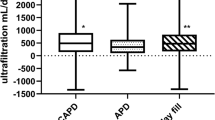Abstract
Eight children, aged 15 months to 17 years 9 months, maintained by continuous ambulatory peritoneal dialysis (CAPD)/continuous cycling peritoneal dialysis and nine adults, aged 20–59 years, managed by CAPD were compared using a standardized peritoneal dialysis protocol, the peritoneal equilibration test (PET). The peritoncal glucose concentration tended to equilibrate with the serum glucose more rapidly in children, but the percentage of the glucose load absorbed was not different between the two age groups. There was an inverse trend between the percentage of glucose absorbed and age in children. Peritoneal creatinine clearance scaled to surface area in children was significantly less than that of the adults; however, the clearances became similar when adjusted for body weight. Peritoneal creatinine clearace scaled to surface area bore a positive and significant relationship to age which, when expressed per kilogram body weight, disappeared. Children had a significantly higher dialysate/plasma (D.P) creatinine ratio after the first 2 h of the PET, but this ratio approached unity by 4 and was not different from adults. The fractional change in the creatinine D/P ratio during the PET was not different between the two age groups. Drain volume adjusted to surface area was significantly less in children than adults. This difference was reversed when drain volume was factored by weight. Similarly drain volume scaled to surface area demonstrated a significant and positive relationship to age, which disappeared when drain volume was expressed per kilogram body weight. Ultrafiltration, whether factored by weight or scaled to surface area, did not differ between the two groups. The post-PEt residual volume corrected for body weight was significantly larger in the children, but bore no relationship to age. It is possible that this larger residual volume in children functions as a tidal volume enhancing solute equilibration.
Similar content being viewed by others
References
Twardowski ZJ (1987) Peritoneal equilibration test. Perit Dial Bull 7: 138–147
Mactier RA, Khanna R, Moore H, Russ J, Nolph KD, Groshong T (1988) Kinetics of peritoneal dialysis in children: role of lymphatics. Kidney Int 34: 82–88
Kohaut EC, Alexander SR (1982) Ultrafiltration in the young patient on CAPD. In: Moncrief JW, Popovich RP (eds) CAPD update. Massen, New York, pp 221–226
Schroder CH, Van Dreumel MJ, Reddingius R, Theeuwes AGM, Williams HL, Jong MCJW de, Monnens LAH (1991) Peritoneal transport kinetics of glucose, urea, and creatinine during infancy and childhood. Perit Dial Int 11: 322–325
Balfe JW, Vigneux A, Williamson J, Hardy BE (1981) The use of CAPD in the treatment of children with end-stage renal disease. Perit Dial Bull 1: 35–38
Gruskin AB, Cote ML, Baluarte HJ (1982) Peritoneal diffusion curves, peritoneal clearances and scaling factors in children of differing age. Int J Pediatr Nephrol 3: 271–278
Author information
Authors and Affiliations
Rights and permissions
About this article
Cite this article
Hanna, J.D., Foreman, J.W., Gehr, T.W.B. et al. The peritoneal equilibration test in children. Pediatr Nephrol 7, 731–734 (1993). https://doi.org/10.1007/BF01213336
Received:
Revised:
Accepted:
Issue Date:
DOI: https://doi.org/10.1007/BF01213336




